 For the true book nerds out there, the 42nd street branch of the New York Public Library is one of the most special places in the entire city, let alone in the entire world. It's majestic, it's amazing, it's accessible and mysterious all at once. And in an unexpected turn of events, I got to stay there overnight. If you've ever read the book "From the Mixed-Up Files of Mrs. Basil E. Frankweiler," you'll know how magical this prospect must seem. Take 1 majestic building celebrating its centenary year, 500 literary nerds, and an all-night scavenger hunt...and then add the final prize: your work from that hunt, printed, sewn by hand into a bound volume, and kept in the library's permanent collection for as long as New York will be standing. I was sold.
For the true book nerds out there, the 42nd street branch of the New York Public Library is one of the most special places in the entire city, let alone in the entire world. It's majestic, it's amazing, it's accessible and mysterious all at once. And in an unexpected turn of events, I got to stay there overnight. If you've ever read the book "From the Mixed-Up Files of Mrs. Basil E. Frankweiler," you'll know how magical this prospect must seem. Take 1 majestic building celebrating its centenary year, 500 literary nerds, and an all-night scavenger hunt...and then add the final prize: your work from that hunt, printed, sewn by hand into a bound volume, and kept in the library's permanent collection for as long as New York will be standing. I was sold.
 It is customary to greet the lions at the NYPL when you first enter, whether they be made of stone (and ideal for writing your release form on), or of plush costume fur. We were told that the lions were named Patience and Fortitude--some say by Major Fiorello LaGuardia, to honor the two qualities that New Yorkers would most require during the years of the great depression. But others say that they are the pillars of intellectual endeavors...
It is customary to greet the lions at the NYPL when you first enter, whether they be made of stone (and ideal for writing your release form on), or of plush costume fur. We were told that the lions were named Patience and Fortitude--some say by Major Fiorello LaGuardia, to honor the two qualities that New Yorkers would most require during the years of the great depression. But others say that they are the pillars of intellectual endeavors... And others say that they are made of Legos. At least this year.
And others say that they are made of Legos. At least this year.As 500 people piled in to the library, we knew that we had to rise to the challenge, to earn the right to stay up all night in these hallowed halls. The quote above our entrance to the Rose Reading room, our home base from 8:00pm to 6:00am, was daunting: "A good book is the precious lifeblood of a master spirit, embalmed and treasured up on purpose to a life beyond life." John Milton was onto something.

 We found our seats and were filled in on our challenge by Jane McGonigal, the game's creator. Over the course of the next 10 hours, we had a tremendous task ahead of us: to find 100 artifacts throughout the library, activate them by scanning QR codes on our smart phones, and unlocking writing challenges that would ask us to think about how each artifact contributed to the world we have inherited, and the world we hope to create. This could be anything from unlocking the Declaration of Independence (and writing your own declaration), to playing a game of charades, to writing a tall tale inspired by the story of George Washington and his cherry tree. Each moment from the past prompted an investigation (and proclamation) about the future.
We found our seats and were filled in on our challenge by Jane McGonigal, the game's creator. Over the course of the next 10 hours, we had a tremendous task ahead of us: to find 100 artifacts throughout the library, activate them by scanning QR codes on our smart phones, and unlocking writing challenges that would ask us to think about how each artifact contributed to the world we have inherited, and the world we hope to create. This could be anything from unlocking the Declaration of Independence (and writing your own declaration), to playing a game of charades, to writing a tall tale inspired by the story of George Washington and his cherry tree. Each moment from the past prompted an investigation (and proclamation) about the future. And the artifacts could be anything...a South African Freedom Charter, just before apartheid fell...
And the artifacts could be anything...a South African Freedom Charter, just before apartheid fell...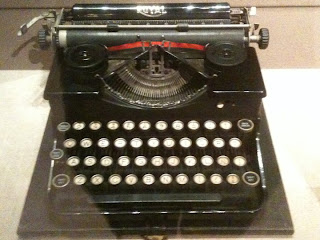 E.E. Cummings' typewriter (note: it does indeed have capital letters on it)...
E.E. Cummings' typewriter (note: it does indeed have capital letters on it)... The engagement ring given to Harriet Westbrook by Percy Bysshe Shelley. It wouldn't be long before he would leave her for the pregnant Mary Wollstone Godwin, later his second wife and the author of "Frankenstein."
The engagement ring given to Harriet Westbrook by Percy Bysshe Shelley. It wouldn't be long before he would leave her for the pregnant Mary Wollstone Godwin, later his second wife and the author of "Frankenstein." QR codes were placed on all kinds of items (even those to keep our hands clean), and the challenges they unlocked kept us busy.
QR codes were placed on all kinds of items (even those to keep our hands clean), and the challenges they unlocked kept us busy. But in the middle of all of this hunting and creating, we got another treat: we went down into the famed stacks beneath the circulation desk of the NYPL. 7 miles in all, it's a labyrinthian place. People rarely get to go see them, but we got full-on tours. And throughout the stacks were postcards, addressed to all of us, congratulating us on how we were finding ways to change the future. (To apply for the chance to attend, you had to complete this sentence: "In 2021 I will be the first person to...". And the future says that, indeed, you did accomplish it.) You were unlikely to draw the card that held your future, so it became your mission for the rest of the night to find the person whose future you had drawn.
But in the middle of all of this hunting and creating, we got another treat: we went down into the famed stacks beneath the circulation desk of the NYPL. 7 miles in all, it's a labyrinthian place. People rarely get to go see them, but we got full-on tours. And throughout the stacks were postcards, addressed to all of us, congratulating us on how we were finding ways to change the future. (To apply for the chance to attend, you had to complete this sentence: "In 2021 I will be the first person to...". And the future says that, indeed, you did accomplish it.) You were unlikely to draw the card that held your future, so it became your mission for the rest of the night to find the person whose future you had drawn.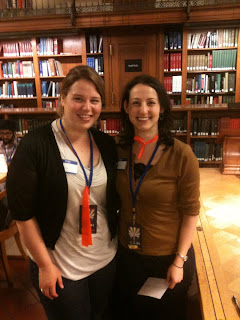 Ashley found my future hidden in stacks relating to food and cooking--not surprising, given that I said I would be the first person to "destroy all restaurants by spreading the gospel of the home cook (and instituting Julia Child's cookbook as a religious text.)" A fellow food writer, she found me, and all around us people applauded. When one person helps another person find their future, it seems like it's fated, and a true cause for celebration.
Ashley found my future hidden in stacks relating to food and cooking--not surprising, given that I said I would be the first person to "destroy all restaurants by spreading the gospel of the home cook (and instituting Julia Child's cookbook as a religious text.)" A fellow food writer, she found me, and all around us people applauded. When one person helps another person find their future, it seems like it's fated, and a true cause for celebration. But even in the midst of all this future-finding, there was still so much to look at from the past...the love letters from John Keats to Fanny Brawne (swoon)...
But even in the midst of all this future-finding, there was still so much to look at from the past...the love letters from John Keats to Fanny Brawne (swoon)...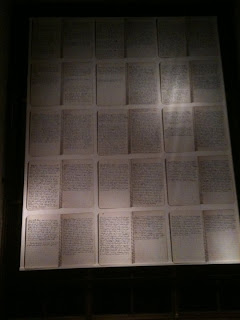 The journals of Malcolm X as he completed his 1964 hajj to Mecca...
The journals of Malcolm X as he completed his 1964 hajj to Mecca...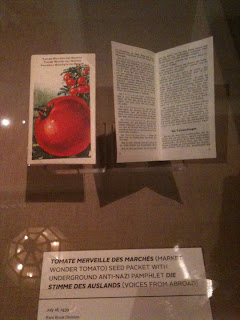 Packets of seeds that were used to transport messages from the Resistance during the Third Reich...
Packets of seeds that were used to transport messages from the Resistance during the Third Reich... And then the really geeky literary artifacts...Charlotte Bronte's writing desk...
And then the really geeky literary artifacts...Charlotte Bronte's writing desk... Sketches from Maurice Sendak in the children's room sign-in book...
Sketches from Maurice Sendak in the children's room sign-in book... And Virginia Woolf's walking stick. It was found in the river, not far from her body after she weighed down her pockets and committed suicide by drowning. An eerie sight, especially when you catch it at 3:30am in a nearly silent library.
And Virginia Woolf's walking stick. It was found in the river, not far from her body after she weighed down her pockets and committed suicide by drowning. An eerie sight, especially when you catch it at 3:30am in a nearly silent library. I spotted this guy in the Gottesman Exhibition Hall, where many of these artifacts are housed, quietly humming to himself and waving his hand over a document. I watched him for a while, then realized that he was conducting an imaginary orchestra as he looked over an original print of the score to the "Star-Spangled Banner." These artifacts resonated with everyone that saw them, and each person found an artifact that spoke to them, that moved them deeply. A large number of these very special artifacts are featured in the 42nd St. branch in the Gottesman hall through the end of this year--I cannot recommend this exhibit enough, so if you're in New York, make a special effort to come and see it for yourself.
I spotted this guy in the Gottesman Exhibition Hall, where many of these artifacts are housed, quietly humming to himself and waving his hand over a document. I watched him for a while, then realized that he was conducting an imaginary orchestra as he looked over an original print of the score to the "Star-Spangled Banner." These artifacts resonated with everyone that saw them, and each person found an artifact that spoke to them, that moved them deeply. A large number of these very special artifacts are featured in the 42nd St. branch in the Gottesman hall through the end of this year--I cannot recommend this exhibit enough, so if you're in New York, make a special effort to come and see it for yourself.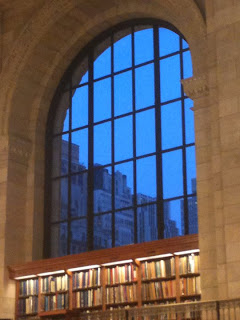 Light was starting to come up through the windows of the Rose Reading Room, and the book was starting to come together at last.
Light was starting to come up through the windows of the Rose Reading Room, and the book was starting to come together at last. It wasn't just any old all-nighter...we had produced a real tome. Even bleary-eyed and caffeine-deprived, it felt like a real accomplishment.
It wasn't just any old all-nighter...we had produced a real tome. Even bleary-eyed and caffeine-deprived, it felt like a real accomplishment. This suddenly felt quite epic...but there was one more thing we had to do before leaving the library. We had to sign it. All 500 of us. To prove we had been there, that we'd see these pieces of the past, that we'd made an effort to envision the future.
This suddenly felt quite epic...but there was one more thing we had to do before leaving the library. We had to sign it. All 500 of us. To prove we had been there, that we'd see these pieces of the past, that we'd made an effort to envision the future.
 I signed my name, packed my bag, and slipped out into the early Midtown morning light. It's so rare for me to get to see the city still quiet, not yet moving, and I felt strangely powerful. All day long I hear people bemoaning the death of reading, of books, and yet I'd spent the night with 500 people totally committed to seeking out knowledge, to imagining worlds they hadn't yet seen. It was a totally invigorating experience, and it made even the most jaded recesses of my publishing brain perk up with excitement. Is this what it feels like to be a newly published writer? Or is it just the thrill of spending time in one of the most special places in the city, and heading out into the dawn with my "future" in my back pocket? Only time will tell...
I signed my name, packed my bag, and slipped out into the early Midtown morning light. It's so rare for me to get to see the city still quiet, not yet moving, and I felt strangely powerful. All day long I hear people bemoaning the death of reading, of books, and yet I'd spent the night with 500 people totally committed to seeking out knowledge, to imagining worlds they hadn't yet seen. It was a totally invigorating experience, and it made even the most jaded recesses of my publishing brain perk up with excitement. Is this what it feels like to be a newly published writer? Or is it just the thrill of spending time in one of the most special places in the city, and heading out into the dawn with my "future" in my back pocket? Only time will tell...












